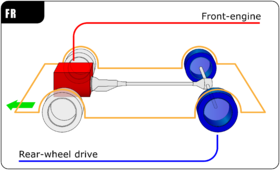| Revision as of 06:53, 9 June 2022 editFrescoBot (talk | contribs)Bots1,135,457 editsm Bot: galleries syntax and minor changes← Previous edit | Revision as of 03:15, 29 August 2022 edit undo200.216.48.2 (talk)No edit summaryNext edit → | ||
| Line 23: | Line 23: | ||
| File:Dodge Viper Motorraum.JPG|Dodge Viper showing its 8.4l V10 positioned behind the car’s front axle | File:Dodge Viper Motorraum.JPG|Dodge Viper showing its 8.4l V10 positioned behind the car’s front axle | ||
| </gallery> | </gallery> | ||
| == See also == | |||
| *] | |||
| == References == | == References == | ||
Revision as of 03:15, 29 August 2022
Automobile layout| This article relies largely or entirely on a single source. Relevant discussion may be found on the talk page. Please help improve this article by introducing citations to additional sources. Find sources: "Front-engine, rear-wheel-drive layout" – news · newspapers · books · scholar · JSTOR (April 2019) |

In automotive design, a FR, or front-engine, rear-wheel-drive layout is one where the engine is located at the front of the vehicle and driven wheels are located at the rear via a drive shaft. This was the traditional automobile layout for most of the 20th century. Modern designs commonly use the front-engine, front-wheel-drive layout (FF). It is also used in high-floor buses and school buses.
Front mid-engine, rear-wheel-drive layout

In automotive design, a front mid-engine, rear-wheel-drive layout (FMR) is one that places the engine in the front, with the rear wheels of vehicle being driven. In contrast to the front-engine, rear-wheel-drive layout (FR), the engine is pushed back far enough that its center of mass is to the rear of the front axle. This aids in weight distribution and reduces the moment of inertia, improving the vehicle's handling. The mechanical layout of an FMR is substantially the same as an FR car. Some models of the same vehicle can be classified as either FR or FMR depending on the length of the installed engine (e.g. 4-cylinder vs. 6-cylinder) and its centre of mass in relation to the front axle.
Characteristics
- FMR cars are often characterized by a long hood and front wheels that are pushed forward to the corners of the vehicle, close to the front bumper. Grand tourers often have FMR layouts, as a rear engine would not leave much space for the rear seats.
- FMR should also not be confused with a "front midships" location of the engine, referring to the engine being located fully behind the front axle centerline, in which case a car meeting the above FMR center of mass definition could be classified as a FR layout instead. The V35 Nissan Skyline / Infiniti G35 / Nissan 350Z are FR cars.
- FMR layout came standard in most pre–World War II, front-engine / rear-wheel-drive cars.
-
All Chevrolet Corvette from the second generation (model year 1963) through the seventh generation (model year 2019) are FMR layouts as seen in the engine bay of the Chevrolet Corvette ZR-1.
-
The Honda S2000 engine sits clearly behind the top of the shock towers.
-
 The Morgan +4 and 4/4 are classic "front mid-engine, rear-wheel-drive layouts".
The Morgan +4 and 4/4 are classic "front mid-engine, rear-wheel-drive layouts".
-
 The engine bay of the Mercedes-Benz SLR McLaren.
The engine bay of the Mercedes-Benz SLR McLaren.
-
 The 4.2-litre V8 in the Maserati Quattroporte V has FMR layout.
The 4.2-litre V8 in the Maserati Quattroporte V has FMR layout.
-
Dodge Viper showing its 8.4l V10 positioned behind the car’s front axle
See also
References
- "Development of a New Hybrid Transmission for RWD Car". www.sae.org. Archived from the original on 2009-02-07. Retrieved 2008-01-11.